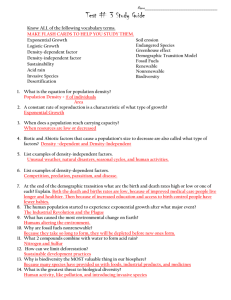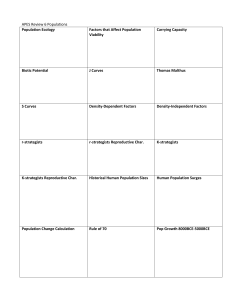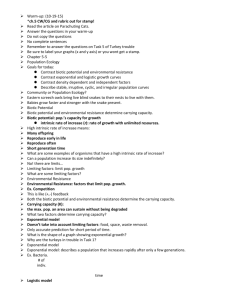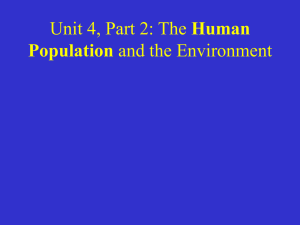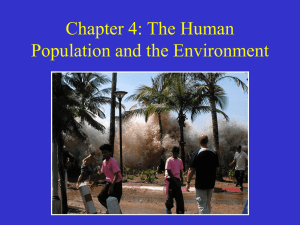File
advertisement
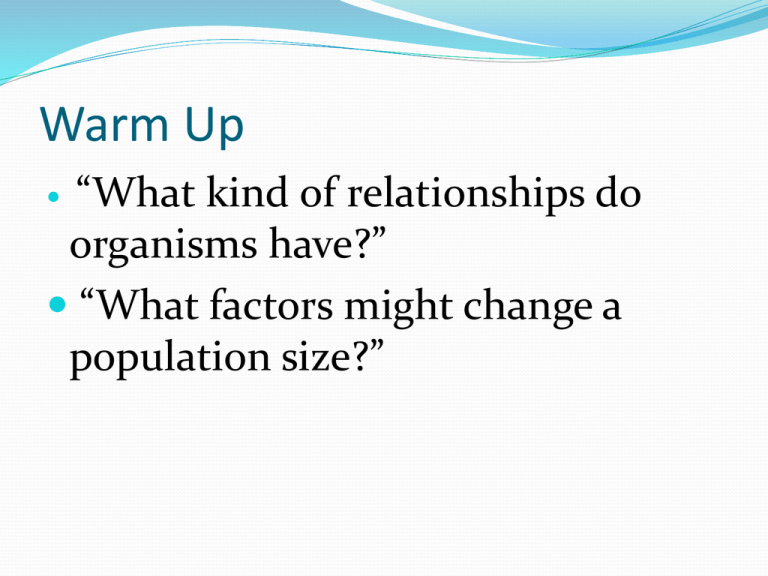
Warm Up “What kind of relationships do organisms have?” “What factors might change a population size?” Question: What does it mean when a population increases or decreases in size with respect to birth rates and death rates? Ch. 5 Objectives – Sections 1 and 2 List the characteristics used to describe a population. Identify factors that affect population size. Differentiate between exponential and logistic growth. Identify factors that limit population growth. Differentiate between density-dependent and density-independent limiting factors. How Populations Grow What is a population? A group of organisms of the same species living in the same area Characteristics of a Population 4 ways to describe a population: 1. Geographic distribution: where the pop. lives 2. Population density: # of individuals / unit area o Ex. 150 frogs live in a pond that is 3 square kilometers. What is the population density? 3. Population growth rate 4. Age structure Population Growth Is a measured a rate of how fast (or slow) a population is growing. It is the size of a population over time. A negative value for population growth rate means the population is decreasing. Population Growth 3 factors that affect pop. size: # births # deaths # individuals that enter or leave Growth = (Births + immigrants) – (Death + emmigrants) Population Growth Immigration: individuals move into an area Emigration: individuals move out of an area Exponential Growth “J-curve” Occurs when indiv. in population reproduce at constant rate Needs ideal conditions and unlimited resources From graphs – what would happen if populations grew uncontrollably?? Logistic growth “S-curve” Population’s growth slows/stops following exponential growth Occurs when resources are less available Population reaches carrying capacity: largest # of indiv. an environment can support Limits to Growth Limiting Factors Causes pop. growth to decrease Density-Dependent Factors Limiting factor that depends on population size Usually strong when pop. is large and dense Density-Dependent Factors Include: Competition Predation Predator-prey relationship: regulates population, best-known mechanism of pop. control Parasitism Disease Predator-prey relationship Density-Independent Factors Affect all pops. the same, regardless of pop. size Usually results in crash in pop. size, followed by building back up Density-Independent Factors Include: Unusual weather Natural disasters Seasonal cycles Certain human activities Exit Slip Give at least 2 factors that can be classified as density dependent and 2 density independent factors. Explain how density dependent factors affect the carrying capacity of an environment. Human Population Growth Objectives Describe how the size of human population has changed over time. Explain why population growth rates differ from country to country. Human Population Growth The human population is still showing exponential growth http://www.census.gov/main/www/popclock.html Population as of 10/26/09 U.S. 307,790,831 - World 6,793,050,389 Population as of 9/28/10 at 11:04am U.S. 310,359,253 - World 6,871,700,813 Patterns of Population Growth Demography: scientific study of human populations Birth/death rates and age structure of pop. help predict why countries grow at different rates Demographic transition A dramatic change in birth/death rates Change from high birth rate and high death rate to low birth rate and low death rate So far, countries that have completed this transition include U.S., Japan, much of Europe Age Structure Shows how many people of different ages make up population Constructing an age pyramid can give information about the growth rate. Age-structure pyramids for the human population of Kenya (growing at 2.1% per year), the United States (growing at 0.6% per year), and Italy (zero growth) for 1995 What’s going to happen to human population growth???? Estimates for Earth’s carrying capacity range from 2 billion to 40 billion.


